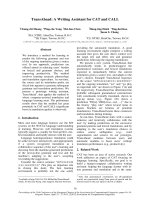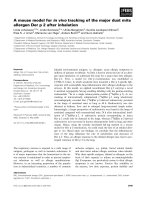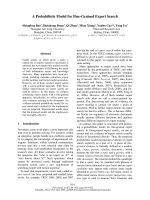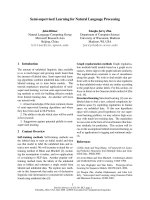Báo cáo khoa học: "A BIDIRECTIONAL MODEL FOR NATURAL LANGUAGE PROCESSING" pdf
Bạn đang xem bản rút gọn của tài liệu. Xem và tải ngay bản đầy đủ của tài liệu tại đây (652.84 KB, 6 trang )
A LANGUAGE
i
BIDIRECTIONAL MODEL FOR NATURAL
PROCESSING
Gtinter Neumann
Lehrstuhl fur Computerlinguistik
Universit~it des Saarlandes
Im Stadtwald 15, Bau 17.2
6600 Saarbriicken 11, FRG
ABSTRACT
In this paper* I will argue for a model of
grammatical processing that is based on
uniform processing and knowledge sources.
The main feature of this model is to view
parsing and generation as two strongly
interleaved tasks performed by a single
parametrized deduction process. It will be
shown that this view supports flexible and
efficient natural language processing.
1 INTRODUCTION
The aspect of bidirectionality has been
gaining importance since the growing rate of
research on natural language generation over
the last years offers us deeper insights into
this cognitive ability of humans. There are
theoretical as well as practical reasons for
adopting bidirectionality. Theoretically, the
assumption of common knowledge sources
for both generation and analysis is essential
for the view of language as "an interpersonal
medium and an interface to thought"
(McDonald 1987). From a psychological
point of view, there is a certain amount of
empirical evidence for shared processors or
facilities (Jackendoff 1987): From a system
engineering view, a bidirectional system
produces utterances only from that subset of
language that it is capable to understand.
Therefore, inconsistencies of the language
behaviour of the system can be avoided
(Jacobs 1988).
A fundamental requirement of a
bidirectional knowledge base is that it be
represented declaratively (Appelt 1987). From
this viewpoint one can distinguish two
different types of bidirectional natural
hmguage systems:
° systems that use uniform knowledge
sources, but different processes
• systems that use uniform knowledge
sources as well as uniform processes 1
Up to now, systems that are capable of
analysing and producing language fall into the
first class, i.e. they use different operations
for both directions (cf. Hoeppner et al. 1983;
Busemann and Hauenschild 1988; Allgayer et
al. 1989) Currently, it is an open question
what degree of bidirectionality should or
could be desired (cf. Appelt 1987; Mann
1987; McDonald 1987; Shieber 1988; Jacobs
1988). One of the reasons could be that the
formal specification of some tasks (e.g., the
determination of content in generation) is
currently not well understood in order to
decide whether they could be bidirectional in
principle.
But in some research areas uniform
processing models have been developed that
are based on formalisms which are well suited
for uniform irepresentation and processing,
e.g., Koskenniemi's (1984) two-level model
of morphology. Recently, there are first
approaches to uniform architectures for
grammaticallprocessing (e.g., Shieber 1988;
Dymetman and Isabelle 1988; Dymetman et
al. 1990). These architectures are based on
Pereira and lWarren's (1983) paradigm of
parsing as deduction. In principle, parsing
and generation are viewed as a single
parametrizeddeduction process.
PROBLEMS OF BIDIRECTIONAL
GRAMMATICAL PROCESSING
* Thanks to Klaus Netter, Karel Oliva, Norbert
Reithinger, Harald Trost and Hans Uszkoreit for
fruitful discussions about the aspects of the paper's
contents.
1Besides these two classes there are also systems that
use different knowledge sources that are compiled from
the same source (e.g., Horacek and Pyka 1988) and
systems that use common basic representation devices
• (e.g., Lancel et,al. 1988; Neumann and Finkler 1990).
- 245 -
Currently developed approaches that
consider parsing as well as generation (e.g.,
Shieber 1988; Shieber et al. 1990; Dymetman
et al. 1990; van Noord 1990; Zajac and Emele
1990) assume:
° that both tasks take place independently
from each other, i.e. an utterance is either
generated or parsed and
• that grammatical processing can be
performed without considerations of
discourse.
A great problem with this view is that it offers
no solution of the problem of choice between
paraphrases in generation: The proposed
approaches assume - more or less explicitly -
modularity between the conceptual and
grammatical component of a natural language
system. 2 A great advantage of a modular
design especially for uniform architectures is
that it is possible to view the grammatical
component as relatively autonomous and self-
contained (cf. Appelt 87).
But then the following problems emerge:
The conceptual component will be unable to
exactly specify the logical form as input to the
grammatical component that will precisely
lead to the utterance that reflects the intended
meaning unless the conceptual module has
detailed information about the grammar and
knows when to use a specific construction
(which renders the modular design
meaningless).
On the other hand, when parsing and
generation are performed within the
grammatical component by a single process
only then the opposite view of computing all
possible parses of an utterance is the
computation of all possible paraphrases of a
logical form. When gramm~ttical processing
should be modelled by means of a
bidirectional grammar, the declarative
structure of the grammar must not contain
pragmatical or stylistical information because
of the modular design. But then the process
can only choose randomly between
paraphrases during generation and this means
that the intended meaning will possibly not be
conveyed.
Ideally, a logical language would be
helpful which necessarily and sufficiently
represents all meaning distinctions of natural
2By a conceptual component I mean either the what-
to-say component of a generation system or the
component that performs inference, plan recognition
or anaphora resolution of an understanding system.
language. But as Shieber (1988) states "this
is just the central problem of knowledge
representation for natural language 10
general". Currently, there exist only
approximate solutions to this problem for
example the use of canonical logical forms
(cf. Shieber 88). 3 But this still offers no
solution of the problem of choice between
paraphrases.
In this paper it will be argued that the
following two points will contribute to an
approximate solution:
• interleaved parsing and generation
° using the language use of interlocutors as
an additional access criterion to linguistic
knowledge
Interleaved parsing and generation means that
both tasks take place in parallel (see section
2). In principle this results in a bidirectional
and incremental flow of information during
natural language processing (see section 4.1).
An important point during the use of language
is that the Choice of linguistic material is
influenced by the language use of others (see
section 3). This leads to more flexibility: not
all necessary parameters (e.g., pragmatical
values) need to be specified in the input of a
generator because decision points can also be
set dynamically during run-time.
A promising approach to realize these two
features will be to base grammatical
processing on a uniform process that is
parametrized by means of a declaratively
specified preference structure of knowledge
sources. But, it is necessary to be aware that
the grammatical component must be assumed
to be an integrated part of a whole natural
language system (in particular in models for
performing dialogs) in order to realize this
solution. ;
Before the architecture of the model will be
described in section 4 the two issues are
explained in more detail in the next sections.
2 INTERLEAVING GENERATION
AND ANALYSIS
The strategy of viewing natural language
processing as based on a uniform deduction
process has a formal elegance and results in
more compact systems. There is one further
advantage that is of both theoretical and
practical relevance: uniform architectures offer
the possibility to view generation and parsing
as strongly interleaved tasks. By this I mean
3It is questionable whether there exists a full solution.
- 246 -
that during performing one task (e.g.,
generation) the other one (e.g., analysis) is
used for monitoring the former. In principle
this results in a bidirectional and incremental
flow of information:
• During the parse of an utterance the
addressee of the utterance can
simultaneously start to construct his
answer. In doing so, partial results of the
parsing process can be used directly during
generation (e.g., if a paraphrase will be
generated). In such flow of control it will
be possible that generation can be used for
completing the resulting structure of
elliptic, underspecified or ill-formed input
during the process of understanding or for
generating paraphrases in due time.
• During generation interleaved parsing could
help to avoid the construction of
ambiguous utterances. E.g., it is necessary
for a natural language help system to
generate utterances that reflect exactly the
intended meaning (if possible at all) to be
sure that the dialog partner will perform the
correct operations. For instance, producing
the utterance "Remove the folder by means
of the system tools" is better than "Remove
the folder with the system tools" because
for the latter utterance there exists the
reading "Remove the folder that contains
the system tools", too.
Of course, it is also possible to analyse a
generated utterance if processes are
performing their tasks in an isolated way. 4 In
such flow of control the complete istructure
has to be generated again if ambiguities are
detected that have to be avoided. BeCause the
source of an ambiguous utterance is not used
directly to guide the generation process it is
possible that the newly generated structure is
still ambiguous (and it may happen that the
same ambiguous structure is generated again).
This results in inefficient systems because in
general the loop between the i isolated
processes must be performed several' times.
The advantage of a uniform architecture is
that intermediate results of one direction can
4For example, the complete structure of a produced
utte~mce is analysed during [he 'anticipation-feedback-
loop' of the HAM-ANS system (see Hoeppner et al.
1983) to determine whether it can be actually uttered
elliptic or not.
immediately be used in the opposite direction
to determine the ambiguous information in
due time.
3 BIDIRECTIONALITY SUPPORTS
FLEXIBLE AND EFFICIENT
GENERATION
One of the disadvantages of currently
developed generation systems is that they
view the structure of linguistic knowledge
only statically. If alternatives exist for a
particular linguistic expression, decision
points are evaluated to determine the
appropriate actual utterance. It is necessary to
specify corresponding decision points for all
possible utterances otherwise the choice must
be performed randomly (the determination of
the appropriate set of decision points is one of
the sources of complexity in existing
generation systems). The flexibility of such
systems depends directly on the flexibility that
is brought into the system via the decision
points that are specified by hand during the
development of a generation system (i.e. the
flexibility is restricted).
On the other side, in a bidirectional system
the resulting structures of the parsing task can
be used directly during generation. E.g., in
general a set :of alternative lexemes is specified
during the process of lexical choice which are
synonymous in the actual situation or when
the semantic input cannot be sufficiently
specified (e!g., in German, some drinking-
devices can be denoted either 'Tasse' (cup) or
'Becher' (mtip) because their shape cannot be
interpreted Unequivocally). An appropriate
choice would be to use the same lexeme that
was previously used by the hearer (if no other
information is available). In principle this is
also possible for the choice between
alternative syntactic structures.
This means that uniform architectures offer
the possibility to model the assumption that
during communication the use of language of
one interlocutor is influenced by means of the
language use of the others. This adaptability
to the use of language of partners in
communication is one of the sources for the
fact that the global generation process of
humans is flexible and efficient. Of course,
adaptability is also a kind of co-operative
behaviour. This is necessary if new ideas
have to be expressed for which no mutually
known linguistic terms exist (e.g., during
communication between experts and novices).
In this case adaptability to the use of language
247 -
of the hearer is necessary in order to make
possible that the hearer will be able to
understand the new information.
I do not want to argue that all choices are
determined by means of language use of
others. But, when structures that are
determined during analysis are considered
during generation, the number of decision
points or parameters which have to be
specified during the development of a
generation system is reduced. This leads to
more flexibility: not all necessary parameters
need to be specified in the input of a
generator because decision points can also be
set dynamically during run-time.
This dynamic behaviour of a generation
system will increase efficiency, too. As
McDonald et al. (1987) define, one generator
design is more efficient than another, if it is
able to solve the same problem with fewer
steps. They argue that "the key element
governing the difficulty of utterance
production is the degree of familiarity with the
situation". The efficiency of the generation
process depends on the competence and
experience one has acquired for a particular
situation. In such situations the generation
process performs its task by using compiled
knowledge and preferences.
Currently, it is a great problem how
compiled knowledge is acquired dynamically
and how it is activated in particular situations.
But a uniform architecture as proposed in this
paper seems to be a promising basis for
designing such a system, because the
structures determined during analysislcould be
used for restricting the potential search space.
4 AN OUTLINE OF A
BIDIRECTIONAL ARCHITECTURE
If both aspects - interleaving parsing and
generation and using the language use of
interlocutors as additional criterion for the
structure of linguistic knowledge - are realized
within a uniform architecture thenthis will
increase flexibility and efficiency in natural
language processing. E.g., when starting the
generation from a :logical form, the
grammatical process is able to ::call the
conceptual module's attention if a subphrase
causes ambiguity. Thus it is not necessary that
the conceptual module has detailed
information about the grammar.
The flow of control within a system based
on an interleaved approach is bidirectional.
E.g., during the generation of an utterance
partial structures are analysed to avoid
unnecessary ambiguities. The bidirectional
flow of control supports incremental
processing: it is possible to start processing of
partial structures before the whole structure is
known. In Finkler and Neumann (1989) and
Neumann and Finkler (1990) we have already
described an implemented generation system
(named POPEL-HOW) that realizes an
incremental and bidirectional flow of control
based on a uniform parallel processing model.
The incremental and bidirectional flow of
control has two main advantages during
generation. Firstly, the determination of
contents can be done on the basis of
conceptual considerations only, because
POPEL-HOW is flexible enough to handle
underspecified input. Secondly, the
conceptualizer has to regard feedback from
POPEL-HOW during the computation of the
further selection process. This means, an
incremental system like POPEL can model the
influence of linguistic restrictions on the
process that determines what to say next.
Underspecified structures are analysed in
POPEL-HOW at each level of description by
means of declarative described mapping rules.
The analysis of such structures is performed
with generation specific operations. If the
system would be based on a uniform
architecture then such specific operations are
no more necessary.
4.1 BiLD - A
MODEL FOR
BIDRECTIONAL LINGUISTIC
DEDUCTION
At the University of Saarbriicken a project
called BiLD is now being started where it will
be investigated how interleaving of parsing
and generation can be efficiently performed
and how such a model can be used for
increasing flexibility and efficiency during
natural language processing. Fig. 1 (next
page) shows the schematic structure of its
architecture.
The core of the system is a uniform
parametrized deduction process. The main
task for the process in both directions is the
determination of the corresponding syntactic
informationi'that functions as an interface
between graphematic and semantic
information (a formalism based on Head-
driven Phrase Structure Grammar (Pollard
and Sag 1987) will be used).
- 248 -
lemllntlo
exprelsiOn
I T
linguistic
deduction
process
I°'n::.:r: '-
I
and
I
Ioxloon
complied
ilruolurel
LI I I lit IrlOll
Fig. 1 : Schematic structure of BiLD
The task of the deduction process during
generation is to construct the graphematic
form of a specified semantical feature
description. 5 For example, to yield the
utterance "A man sings" the deduction process
gets as input the semantic feature structure
I [rel : sing'
sem" | [quant : exist'
"/
/vat:El
,-
|agenS:|restr [pred : man|
L
t
:tvar: l
]
and deduces the graphematic structure
[graph : (A_man_sings.) ]
by means of successive application of lexical
and grammatical information. In the same way
the deduction process computes from the
graphematic structure an appropriate :semantic
structure in parsing direction.
The author has now started to develop and
implement a first version of a prototype of a
uniform algorithm for HPSG. The main idea 6
is that the approach is head-driven in both
directions. In the first phase of the algorithm
the maximal projection for all head elements
are computed (or predicted) bottom-up.
Phrases are then combined top-down. The
completion step is controlled by syntactic and
semantic information inherited from lexical
heads and by the principles of HPSG.
5The resulting structure of the generation :process as
well as the input structure of the parsing process is
written language, therefore we use the feature 'graph'
instead of 'phon' which is preferably used in Pollard
and Sag (1987).
6Basic ideas of the approach are influenced by the
head-driven parser of Proudian and Pollard (1985).
Because heads are processed first the
completion of structures must be performed in
left as well as in right direction.
The approach supports the ID/LP format
of rules. But it is an open question whether
linear precendence can be processed in the
same way for generation and parsing. The
problem is that during parsing the task of LP
rules is to filter out ungrammatical structures.
During generation the task of LP rules can be
seen as an ordering criterion. But in this case
the problem of choice between paraphrases
emerges. In POPEL-HOW it is assumed that
the order of activation of concepts (which is
determined using pragmatical knowledge)
should be maintained if it is syntactically
wellformed; otherwise the segments are
reordered. Whether such viewpoint is
acceptable for generation in general is still
open.
4.2 ASPECTS OF CONTROL
STRUCTURE
A major aspect of the BiLD project is that
specific parametrization of the deduction
process is represented in the lexicon as well
as in the grammar to obtain efficient structures
of control (Uszkoreit 1991). The main idea is
that preference values are assigned to the
elements (disjuncts or conjuncts) of feature
descriptions. For example, in HPSG all
lexical entries are put together into one large
disjunctive form. From a purely declarative
point of view these elements are unordered.
But a preference structure is usrd during
processing in order to guide the process of
lexical choice efficiently which itself
influences the grammatical process.
To support flexibility and efficiency (in the
way described in section 3) the language use
of interlocutors will be considered to influence
the preference values. For example, the
frequency of access of a lexeme will increase
its preference value. In a uniform lexicon it is
no matter whether the lexeme was accessed
during parsing or generation. But this means
that the use of particular linguistic elements of
the interlocutor influences the choice of lexical
material during generation.
5 CONCLUSION
In this paper it is argued that generation
and parsing should be best viewed as two
interleaved tasks based on a single
parametrized deduction process and that this
view supports flexible and efficient natural
- 249,
language processing. A major point of view is
that the language use of interlocutors should
be considered during generation as an
additional access criterion.
REFERENCES
Allgayer J.; Jansen-Winkeln R.; Reddig C. and
Reithinger N. 1989 "Bidirectional use of knowledge
in the multi-modal NL access system XTRA",
Proceedings of the l l th International Joint Conference
on Artificial Intelligence, 1492-1497.
Appelt, D. E. 1987 "Bidirectional Grammars and
the Design of Natural Language Generation
Systems," In Y. Wilks (ed.) Theoretical Issues in
Natural Processing-3, New Mexico State University,
Las Cruces, New Mexico, 185-191.
Busemann, S. and Hauenschild, C. i988 "A
Constructive View of GPSG or How to Make It
Work," Proceedings of the 12th International
Conference on Computational Linguistics, 77-82.
Dymetman, M. and Isabelle, P. 1988 "Reversible
Logic Grammars for Machine Translation,"
Proceedings of the 2nd International Conference on
Theoretical and Methodological Issues in Machine
Translation of Natural Language.
Dymetman, M.; Isabelle P. and Perrauit, F. 1990
"A Symmetrical Approach to Parsing and Generation,"
Proceedings of the 13th International Conference on
Computational Linguistics, 90-96.
Finkler, W. and Neumann, G. 1989 "POPEL-
HOW: A Distributed Parallel Model for Incremental
Natural Language Production with Feedback,"
Proceedings of the Eleventh International Joint
Conference on Artificial Intelligence, 1518-t523.
Hoeppner, W.; Christaller, T.; Marburger, H.;
Morik, K.; Nebel, B.; O'Leary, M. and Wahlster, W.
1983 "Beyond Domain-Independence: Experience with
the Development of a Gel'man Language Access
System To Higly Diverse Background Systems,"
Proceedings of the 8th International Joint Conference
on Artificial Intelligence, 643-646.
Horacek, H. and Pyka, C. 1988 "Anweiadbarkeit
von Unifikationsgrammatiken ftir effizientes
Generieren," In H. Trost (ed.) 4.0sterreichische
Artificial-lntelligence-Tagung, Springer, Berlin, 171-
177.
Jackendoff, R. 1987 "Consciousness and the
Computational Mind," Cambridge Massachussetts:
MIT Press.
Jacobs, P. S. 1988 "Ach!eving Bidirectionality,"
Proceedings of the 12th International Conference on
Computational Linguistics, 267-274.
Koskenniemi, K. 1984 "A General Computational
Model for Word-Form Recognition and Production,"
Proceedings of the lOth International Conference on
Computational Linguistics, 178-181.
Lancel, J.M.; Otani, M.; Simonin, N. and
Danlos, L. 1988 "SAGE: a Sentence Parsing and
Generation System," Proceedings of the 12th
International Conference on Computational
Linguistics, 359-364.
Mann, W. C. 1987 "What is Special About
Natural Language Generation Research?," In Y.
Wilks (ed.) Theoretical Issues in Natural Processing-
3, New Mexico State University, Las Cruces, New
Mexico, 206-211.
McDonald D. D. 1987 "No Better, but no Worse,
than People," In Y. Wiiks (ed.) Theoretical Issues in
Natural Processing-3, New Mexico State University,
Las Cruces, New Mexico, 200-205.
McDonald, D. D.; Meteer, M. W. and
Pustejovsky, J. D. 1987 "Factors Contributing to
Efficiency in Natural Language Generation," In G.
Kempen (ed.) Natural Language Generation: New
Results in Artificial Intelligence, Psychology and
Linguistics, Dordrecht: Martinus Nijhoff, 159-182.
Neumann, G. and Finkler, W. 1990 "A Head,
Driven Approach to Incremental and Parallel
Generation of Syntactic Structures," Proceedings of
the 13th International Conference on Computational
Linguistics, 288-293.
van Noord, G. 1990 "Reversible Unification Based
Machine Translation," Proceedings of the 13th
International Conference on Computational
Linguistics, 299-304.
Pereira, F. C. N. and Warren, D. H. D. 1983
"Parsing as Deduction, " Proceedings of the 21th
Annual Meeting of the Association for
ComputationaL Linguistics, 137-144.
Proudian, D. and Pollard, C. 1985 "Parsing Head,
Driven Phrase iStructure Grammar, " Proceedings of
the 23rd Annual Meeting of the Association for
Computational Linguistics, 167-171.
Pollard, C.! and Sag, I. 1987 "Information-based
syntax and semantics," CLSI Lecture Notes 13, Center
for the Study of Language and Information, Standford,
CA.
Shieber, S. M. 1988 "A Uniform Architecture for
Parsing and Generation," Proceedings of the 12th
International Conference on Computational
Linguistics, 61,4-619.
Shieber, S.iM.; van Noord, G.; Moore, R. M. and
Pereira, F. C. P. 1989 "A Semantic Head-Driven
Generation Algorithm for Unification-Based
Formalisms," Proceedings of the 27th Annual
Meeting of the Association for Computational
Linguistics, 7-17.
Uszkoreit, H. 1991 "Strategies for Adding Control
Information to Declarative Grammars," Technical
Report, Institute for Computational Linguistics,
University of Saarbriicken, FRG.
Zajac, R. and Emele, M. 1990 "Typed Unification
Grammars," Proceedings of the 13th International
Conference onComputational Linguistics, 293-298.
- 250 -









